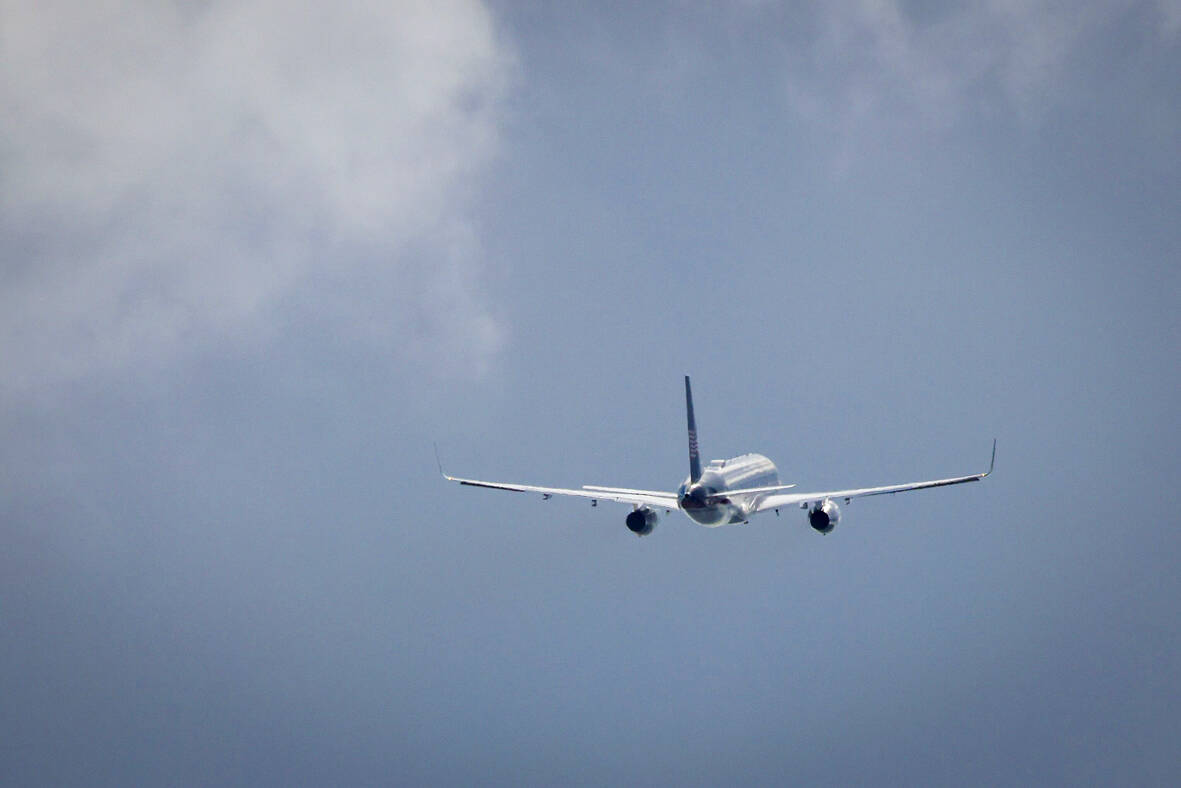A warning as the Northern Hemisphere summer travel season kicks off: air rage is rampant in the post-pandemic world.
Recent unruly behavior includes a man allegedly pinning an American Airlines Group flight attendant to the cockpit door after an argument about vegetarian meals; an Air India passenger being restrained after trying to open the aircraft door and attacking crew; and Qantas Airways and its low-cost carrier Jetstar temporarily banning four drunk men in Australia for allegedly verbally abusing customers and staff.
Globally, there was one disorderly incident reported for every 568 flights last year, up from one per 835 flights in 2021, the International Air Transport Association said in a statement this month, citing data collated from more than 20,000 reports submitted by around 40 airlines. Failure to comply with crew instructions — such as using e-cigarettes and vapes and not fastening seatbelts — increased by more than a third.

Bloomberg
Fraying passenger tempers can be put down to a few things. With lounge access easier than ever, more people are drinking alcohol before boarding. There’s also the general annoyance over high ticket prices and heightened anxiety in wake of COVID. Chaotic airports, lost luggage and flight cancellations as carriers struggle with a lack of planes and labor aren’t helping either.
Now the aviation industry is calling for action. IATA, which represents about 300 airlines accounting for 83 percent of the world’s air traffic, wants more nations to prosecute offending passengers. The Association of Flight Attendants-CWA, which represents US cabin crews, says flight attendants should be given mandatory self-defense training and security beefed up at airport screening points, boarding gates and on planes.
The Federal Aviation Administration has started a campaign with social media memes and airport signs explaining what constitutes disruptive behavior and its potential consequences, said Tim Colehan, IATA’s assistant director for external affairs. Other countries can look to the zero-tolerance approach in the US, which he said deters misbehavior by taking strong enforcement action.
FEAR AND BOOZE
IndiGo Chief Executive Officer Pieter Elbers said since COVID restrictions were lifted there’s been a change in the flying experience and some people are struggling to adjust.
“Planes were pretty empty and suddenly they were full again, and people lost a little bit of that feeling of being with so many people together,” sparking some anxiety, he said.
Those fears are playing out in different ways. A man on an Asiana Airlines flight in South Korea late last month opened an exit door as the plane neared the airport in the city of Daegu in the southeast of the country. He later told police he did it because he felt suffocated and wanted to get off the aircraft.
Fliers have forgotten travel etiquette and they’re not as accustomed to being around strangers after spending long periods at home with limited socializing, said Sara Nelson, president of the Association of Flight Attendants-CWA. The mixed messages and abrupt policy changes around COVID have also agitated some people.
Perhaps unsurprisingly, alcohol abuse is a major contributor to air rage. During the pandemic, takeaway alcohol became common at airports and pushing consumption of booze for profit led to passengers drinking up to the boarding gate with no responsible oversight, Nelson said.
“All of those issues certainly add to the recipe for violence,” said Nelson. “It’s never acceptable.”
IATA said while physical abuse incidents remain rare, there was an increase of 61 percent over 2021, occurring once every 17,200 flights.
GLOBAL PROBLEM
The US has seen 783 air rage incidents so far this year, 49 percent higher than pre-COVID levels, according to the FFA. In the UK, instances last year nearly tripled from 2019 to 1,028, according to the television news channel Sky News.
In Australia, as travelers took to the air again last year, authorities noticed an emerging pattern of disruptive behavior. Australian Federal Police reported a series of what it called air-rage incidents at major airports stemming from missed flights, delays and problems with baggage. Violence also broke out outside terminals in disputes over taxis or ride-share vehicles.
The number of public disturbances, assaults or incidents of intoxication and offensive behavior at Sydney and Melbourne airports — the country’s two primary aviation hubs — soared to 463 between March and September last year from 279 in the same period a year earlier, according to the AFP.
And the problem is getting worse. According to exclusive AFP data, there were 401 similar incidents in Sydney and Melbourne airports this year through May 14. That dwarfs last year’s monthly rate.
Such episodes of bad behavior seem to be especially frequent in India, a nation of 1.4 billion people where flying is new to many. IndiGo, the country’s biggest airline, has trained crew to spot the varying levels of disruptive behavior and take action accordingly.
CEO Elbers said there was one case of a cabin crew member being harassed by a passenger.
“So she replied, ‘I’m not your servant,’ and actually that went viral,” he said. “And she got a lot of support for that. And my reaction was please treat our staff the way you want to be treated.”
The carrier only operates with female cabin crew and doesn’t serve alcohol on domestic flights.
One incident gained particular notoriety last November when a man urinated on another passenger during an Air India flight from New York to New Delhi.
In January, Air India CEO Campbell Wilson said in a statement that the airline reviewed its policy around alcohol service on flights and started an education program to improve its crews’ handling of unruly passengers. The airline gave iPads to pilots and senior cabin crew so they can report incidents to the aviation regulator faster.
Nelson wants more people to talk about air rage. She also urged passengers to step up as helpers and be patient with crew and aviation workers on the ground.
“Our cabins are small microcosms of humanity,” she said. “Social and political issues always show up on planes. It’s really just a handful of bad actors who need to be grounded and face consequences for their violent actions.”

Taiwan doesn’t have a lot of railways, but its network has plenty of history. The government-owned entity that last year became the Taiwan Railway Corp (TRC) has been operating trains since 1891. During the 1895-1945 period of Japanese rule, the colonial government made huge investments in rail infrastructure. The northern port city of Keelung was connected to Kaohsiung in the south. New lines appeared in Pingtung, Yilan and the Hualien-Taitung region. Railway enthusiasts exploring Taiwan will find plenty to amuse themselves. Taipei will soon gain its second rail-themed museum. Elsewhere there’s a number of endearing branch lines and rolling-stock collections, some

The Democratic Progressive Party (DPP), Chinese Nationalist Party (KMT), and the country’s other political groups dare not offend religious groups, says Chen Lih-ming (陳立民), founder of the Taiwan Anti-Religion Alliance (台灣反宗教者聯盟). “It’s the same in other democracies, of course, but because political struggles in Taiwan are extraordinarily fierce, you’ll see candidates visiting several temples each day ahead of elections. That adds impetus to religion here,” says the retired college lecturer. In Japan’s most recent election, the Liberal Democratic Party lost many votes because of its ties to the Unification Church (“the Moonies”). Chen contrasts the progress made by anti-religion movements in

Could Taiwan’s democracy be at risk? There is a lot of apocalyptic commentary right now suggesting that this is the case, but it is always a conspiracy by the other guys — our side is firmly on the side of protecting democracy and always has been, unlike them! The situation is nowhere near that bleak — yet. The concern is that the power struggle between the opposition Chinese Nationalist Party (KMT) and their now effectively pan-blue allies the Taiwan People’s Party (TPP) and the ruling Democratic Progressive Party (DPP) intensifies to the point where democratic functions start to break down. Both

This was not supposed to be an election year. The local media is billing it as the “2025 great recall era” (2025大罷免時代) or the “2025 great recall wave” (2025大罷免潮), with many now just shortening it to “great recall.” As of this writing the number of campaigns that have submitted the requisite one percent of eligible voters signatures in legislative districts is 51 — 35 targeting Chinese Nationalist Party (KMT) caucus lawmakers and 16 targeting Democratic Progressive Party (DPP) lawmakers. The pan-green side has more as they started earlier. Many recall campaigns are billing themselves as “Winter Bluebirds” after the “Bluebird Action”